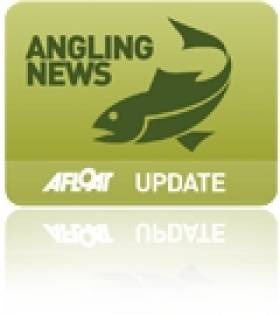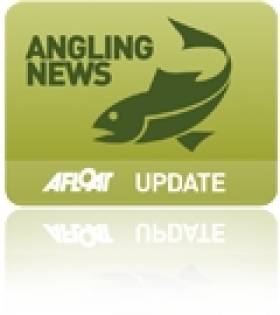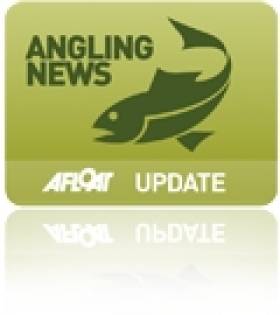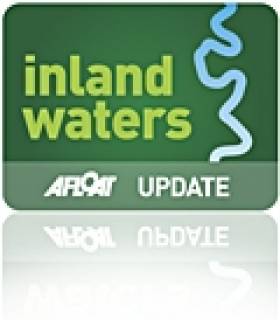Displaying items by tag: Asian clam
Minister Comments On Dredging Plans For Asian Clam At Lanesborough
#AsianClam - The Minister for Natural Resources has commented on plans for dredging at Lough Ree to deal with the recent invasion of Asian clam at Lanesborough.
As reported earlier this week on Afloat.ie, the 'hot water' stretch downstream of the ESB plant near the Co Longford town has reopened to angling under strict bio-security conditions, with disinfection for anglers' gear mandatory.
In his written response to Dáil questions on the matter from Longford-Westmeath TD James Bannon and Roscommon-South Leitrim deputy Denis Naughten, Minister Joe McHugh said on 4 November that despite the "early action" taken by Inland Fisheries Ireland (IFI) to close the fishery, "it is important that all understand that Asian Clam, like many other aquatic invasive species, is extremely pervasive in the environment, and once in a water body it is likely that operations will be focused on managing the infestation rather than eradication."
He added that "responding to this infestation will require co-ordinated action from a number of State agencies and IFI has been facilitating and chairing meetings of relevant agencies since 19 September."
According to the minister, IFI co-ordinated the latest of these meeting on 29 October involving Waterways Ireland, the ESB, the Environmental Protection Agency (EPA), Bord Na Mona and Longford and Roscommon County Councils.
"A method statement for removal works was submitted by Waterways Ireland," he said. "This statement is being considered by the relevant agencies, including Statutory regulatory bodies.
"In the first instance it is anticipated that a trail dredge will take place in advance of a full scale dredging operation. In advance of this an EPA licence will be required for disposal of the dredged material and the classification of the materials will have a bearing on the method and cost of disposal.
"At this point I understand that the overall cost of a full scale dredging operation has yet to be established. However, this will become clear once the material classification is available and it will be possible to accurately estimate the cost."
Lanesborough Reopening Following Asian Clam Invasion
#asianclam – Inland Fisheries Ireland (IFI) has today confirmed that the hot-water stretch in Lanesborough, Co. Longford has re-opened to angling, under strict bio-security conditions.
Four disinfection units, funded by the ESB, have been installed by Inland Fisheries Ireland and are now operational. Two of the units are available above and below Lanesborough Bridge on the bankside, one unit is available at the Lanesborough boat slipway and the fourth unit is available on the Ballyleague angling bank.
IFI has advised that all anglers fishing on this angling stretch must disinfect all fishing equipment and waders on departure.
Signage has been erected at each disinfection unit, containing the appropriate disinfection solution, explaining how to disinfect properly. These units are secured outside normal fishing times but a contact number is available on the signage should an angler require it.
Due to the continued presence of the Asian Clam within this angling stretch, Inland Fisheries Ireland has prohibited the use of any keep net in this area for the foreseeable future.
Lanesborough Asian Clam Report Says Removal 'Not Feasible'
#Angling - Inland Fisheries Ireland (IFI) has published its report on the Asian clam survey at Lanesborough, Co Longford and the surrounding area, which has found that complete removal of the invasive species "is not feasible".
As previously reported on Afloat.ie, IFI said it was working closely with all relevant agencies as well as local community and angling groups to re-open the popular fishery after last month's invasive species scare.
All stakeholders have now been briefed with IFI's report and recommendations and management actions will be considered over the coming weeks.
IFI says an "enormous amount of work has taken place over a short period of time.
"It is clear from the findings of the survey that the population of Asian clam has already reached a stage where complete removal is not feasible."
It's expected that disinfection kits will be commissioned in the coming week to halt any further spread of Asian clam from the Lanesborough fishery.
Fishing is then set to resume thereafter, but anglers are reminded that fishing will remain closed until an official announcement from IFI.
The full report on the Lanesbourough Asian clam situation is available as a PDF to read or to download HERE.
Measures Outlined To Tackle Asian Clam In Longford Angling Waters
#Angling - Inland Fisheries Ireland says it is working closely with all relevant agencies as well as local community and angling groups to put "immediate measures" in place to re-open the Lanesborough fishery to angling after this month's Asian clam scare.
As previously reported on Afloat.ie, IFI prohibited angling at the 'hot water' stretch in Lanesborough, Co Longford after confirmation that the invasive species Corbilcula fluminea was present downstream of the ESB plant on Lough Ree.
In a statement issued late last week (18 September), IFI says disinfection stations, funded by the ESB, will be provided – and managed within the local community – over this week and next.
Combined with "a responsible attitude by all water users", it is hoped this "will facilitate the resumption of angling activity in the community".
The relevant agencies involved – the National Parks and Wildlife Service, Waterways Ireland, ESB, Bord Na Mona, the Office of Public Works and Roscommon and Longford County Councils – unanimously agreed that a detailed scientific survey would be carried out by this weekend.
"This will accumulate quantitative data and the extent of the distribution of this invasive species to augment the knowledge from the preliminary assessments," says IFI, which adds that the outcome "will inform decisions on the collaborative actions required for the medium and long term interventions and strategies".
In addition, the inland fisheries agency underlined that "continued awareness and responsible behaviour by all water users is paramount to ensuring the work of the agencies involved has the best chance for success and the prevention of any further spread.
"In that regard, all of the agencies appeal to the respective stakeholders to continue to observe bio-security measures, seek advice on any planned activity and assist in the efforts to manage a very difficult situation."
Asian Clam Invasive Species Found in Longford
#asianclam – Inland Fisheries Ireland has prohibited angling at the 'hotwater' stretch in Lanesborough, Co. Longford. This emergency response it due to the confirmation of the presence of Asian Clam, Corbilcula fluminea, downstream of the ESB powerplant at the top of Lough Ree. Inland Fisheries Ireland has deployed a rapid response team to erect signs in the location prohibiting angling on this fishery until further notice.
Anglers must be aware of the dangers posed to other waters. Asian clam can spread on fishing equipment such as keep nets, landing nets, boats, rods and clothing. A decision has been made to close this section of the fishery as a temporary measure to avoid the accidental spread of Asian Clam to other waters. The fishery will reopen at the earliest opportunity once bio-security measures for anglers can be introduced. These measures will include disinfection facilities for all angling equipment.
Inland Fisheries Ireland officers received a report this morning, Thursday 11th September 2014, and responded immediately to the popular fishing area. Dr. Joe Caffrey, a Senior Research Officer with Inland Fisheries Ireland, attended the location also and confirmed the presence of the invasive species this afternoon. An initial assessment further downstream did not show signs of a presence of the invasive. A full assessment will be carried out and a meeting is scheduled to take place on Monday 15th September between the relevant agencies to agree the next steps, to ensure that there no further spread towards Lough Ree occurs.
Like the Zebra Mussel (Dreissena polymorpha), Asian Clam has the ability to become highly invasive in a short period of time and at high densities it can alter the food web and compete with native mussel species. Asian clam are known to aggressively out compete native invertebrate communities, limit phytoplankton biomass, biofoul water intakes, alter benthic habitats, add biologically available nitrogen and phosphorus to systems, and impact aesthetic and recreational values of public beaches, lake front properties and swimming areas. Their high rates of filtration, metabolism, reproduction, tolerance to wide ranges of habitats, and juvenile dispersal allows Asian clam to aggressively expand ranges and to rapidly re‐invade areas; limiting management, reducing restoration efforts and impacting native benthic communities. Asian clam are capable of both filter feeding (feeding from the water) and pedal feeding (feeding directly from the sediment).
A fish stock survey carried out by Inland Fisheries Ireland on Lough Ree in March 2014 also included grab sampling for the Asian Clam invasive in 200 sites over the entire lake. No Asian Clam was found at that time.Asian Clam invasive species found in Longford – Angling prohibited until further notice
Inland Fisheries Ireland has prohibited angling at the 'hotwater' stretch in Lanesborough, Co. Longford. This emergency response it due to the confirmation of the presence of Asian Clam, Corbilcula fluminea, downstream of the ESB powerplant at the top of Lough Ree. Inland Fisheries Ireland has deployed a rapid response team to erect signs in the location prohibiting angling on this fishery until further notice.
Anglers must be aware of the dangers posed to other waters. Asian clam can spread on fishing equipment such as keep nets, landing nets, boats, rods and clothing. A decision has been made to close this section of the fishery as a temporary measure to avoid the accidental spread of Asian Clam to other waters. The fishery will reopen at the earliest opportunity once bio-security measures for anglers can be introduced. These measures will include disinfection facilities for all angling equipment.
Inland Fisheries Ireland officers received a report this morning, Thursday 11th September 2014, and responded immediately to the popular fishing area. Dr. Joe Caffrey, a Senior Research Officer with Inland Fisheries Ireland, attended the location also and confirmed the presence of the invasive species this afternoon. An initial assessment further downstream did not show signs of a presence of the invasive. A full assessment will be carried out and a meeting is scheduled to take place on Monday 15th September between the relevant agencies to agree the next steps, to ensure that there no further spread towards Lough Ree occurs.
Like the Zebra Mussel (Dreissena polymorpha), Asian Clam has the ability to become highly invasive in a short period of time and at high densities it can alter the food web and compete with native mussel species. Asian clam are known to aggressively out compete native invertebrate communities, limit phytoplankton biomass, biofoul water intakes, alter benthic habitats, add biologically available nitrogen and phosphorus to systems, and impact aesthetic and recreational values of public beaches, lake front properties and swimming areas. Their high rates of filtration, metabolism, reproduction, tolerance to wide ranges of habitats, and juvenile dispersal allows Asian clam to aggressively expand ranges and to rapidly re‐invade areas; limiting management, reducing restoration efforts and impacting native benthic communities. Asian clam are capable of both filter feeding (feeding from the water) and pedal feeding (feeding directly from the sediment).
A fish stock survey carried out by Inland Fisheries Ireland on Lough Ree in March 2014 also included grab sampling for the Asian Clam invasive in 200 sites over the entire lake. No Asian Clam was found at that time.
#INLAND WATERWAYS - Inland Fisheries Ireland has reiterated its call for assistance in stopping the spread of the invasive Asian clam.
It comes just weeks after the fisheries body was alerted to a reported sighting of the highly invasive species in the Grand Canal at Pollagh in Co Offaly.
As previously reported on Afloat.ie, IFI describes the Asian clam (Corbicula fluminea) as "a most unwelcome addition" to the fauna of Ireland's inland waterways.
The bivalve mollusc is regarded as "one of the most notorious aquatic invasive species in the world", and poses a "major threat to Ireland's habitats, native species and internationally renowned fisheries."
The clam is already firmly established in the River Nore downstream of Inistioge and in the lower Barrow, where it has achieve a "staggering" density of almost 10,000 per square metre, and populations have also been recorded in the River Shannon and in Lough Derg.
IFI warns: "Considering that each clam can produce up to 70,000 juveniles each year, the potential for the enormous expansion of this population is apparent."
In order to limit the further spread of the Asian clam, IFI is urging all water users, particularly anglers and boaters, to implement strict biosecurity measures, including disinfecting all equipment that has been exposed to or used in waterways when moving from one area to another.
Further information on these measures can be found on the website for CAISIE, the Control of Aquatic Invasive Species in Ireland programme, and on the IFI website. Any new sightings of the Asian clam should be reported to IFI immediately.
Trial Dredging to Help Rid Barrow of Invasive Asian Clam
#INLAND WATERWAYS - Trial dredging operations to curtail the spread of Asian clams at designated sites in the lower River Barrow are set to conclude today.
Inland Fisheries Ireland (IFI) employed the use of a a traditional cockle harvesting boat to physically remove the clams from the river bed, in an effort to explore methods of controlling or eradicating what it describes as an "ecosystem-changing invader" in other infested waters.
IFI scientists supervised the trials, using teams of divers to quantify the result of the dredging efforts.
The Asian clam (Corbicula fluminea) is "a most unwelcome addition to the fauna of the lower River Barrow". The bivalve mollusc is regarded as "one of the most notorious aquatic invasive species in the world".
First recorded in the river downstream of St Mullin’s in April 2010, subsequent IFI studies have revealed that the Asian clam is firmly established in the lower Barrow and in the River Nore downstream of Inistioge. Populations have also been recorded in the River Shannon and in Lough Derg.
In one section of the River Barrow the clam has achieved a "staggering" density of almost 10,000 per square metre.
Dr Joe Caffrey, senior scientist with IFI, said of the trial dregding: “It is imperative that every effort is made to control the expansion and spread of this highly adept invasive species.
"The results from these trials will inform future national management plans for this most unwelcome non-native species and will, at the very least, dramatically reduce the numbers of individuals in the test sites.
He added: "In tandem with these trials, research effort is being focused at producing other control methods that can be targeted as this species.”




































































